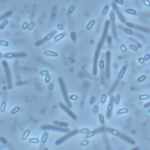Link to Pubmed [PMID] – 18480323
J. Med. Microbiol. 2008 Jun;57(Pt 6):685-9
Clostridium difficile toxin synthesis is growth phase-dependent and is regulated by various environmental signals. The toxin genes tcdA and tcdB are located in a pathogenicity locus, which also includes three accessory genes, tcdR, tcdC and tcdE. TcdR has been shown to act as an alternative sigma factor that mediates positive regulation of both the toxin genes and its own gene. The tcdA, tcdB and tcdR genes are transcribed during the stationary growth phase. The tcdC gene, however, is expressed during exponential phase. This expression pattern suggested that TcdC may act as a negative regulator of toxin gene expression. TcdC is a small acidic protein without any conserved DNA-binding motif. It is able to form dimers and its N-terminal region includes a putative transmembrane domain. Genetic and biochemical evidence showed that TcdC negatively regulates C. difficile toxin synthesis by interfering with the ability of TcdR-containing RNA polymerase to recognize the tcdA and tcdB promoters. In addition, the C. difficile NAP1/027 epidemic strains that produce higher levels of toxins have mutations in tcdC. Interestingly, a frameshift mutation at position 117 of the tcdC coding sequence seems to be, at least in part, responsible for the hypertoxigenicity phenotype of these epidemic strains.

